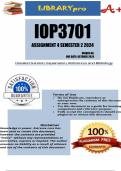Essay
Btec Applied Science Unit 13 Assignment C (Full Assignment)
- Institution
- PEARSON (PEARSON)
This is Btec Applied Science Unit 13 Assignment C (Properties and reactions of transition metal complexes) which was awarded a distinction and contains all the practical results. This is an example of a Distinction level assignment, and you may use it as a guide to help you achieve a distinction an...
[Show more]












